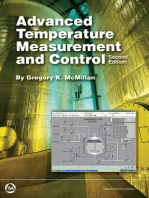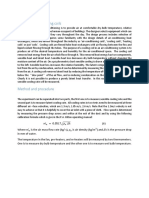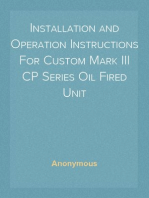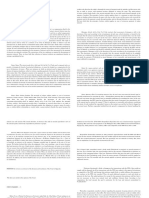2015.06 Why You Cant Rely On Temperature Measurements
2015.06 Why You Cant Rely On Temperature Measurements
Uploaded by
Lasse HansenCopyright:
Available Formats
2015.06 Why You Cant Rely On Temperature Measurements
2015.06 Why You Cant Rely On Temperature Measurements
Uploaded by
Lasse HansenOriginal Description:
Original Title
Copyright
Available Formats
Share this document
Did you find this document useful?
Is this content inappropriate?
Copyright:
Available Formats
2015.06 Why You Cant Rely On Temperature Measurements
2015.06 Why You Cant Rely On Temperature Measurements
Uploaded by
Lasse HansenCopyright:
Available Formats
___________________________________________________________
June 2015
PRO TIP: Why You Cant Rely on Temperature Measurements
Measurement of valve cap and discharge temperatures has been used for many years as a
means to assess the health of compressor components. Many operators and mechanics
routinely monitor these readings in order to identify leaking valves or in-cylinder
recirculation of gases. However, without Pressure-Volume analysis, temperature
readings can be counterintuitive and often misleading.
The volume-pressure-temperature relationships for a gas being compressed by a
reciprocating compressor can be modeled adiabatically, which assumes no heat transfer
to the surrounding environment. While there is some transfer of heat to the atmosphere
or water jacket, the adiabatic model allows us to mathematically calculate the relationship
between temperature and volume as gas is compressed as follows:
where
T2 is the discharge temperature in absolute degrees (Rankine or Kelvin),
T1 is the suction temperature in absolute degrees (Rankine or Kelvin),
p2/p1 is the ratio of absolute pressures, and
k is the ratio of specific heat for the gas
If we assume a constant gas mixture and, therefore a constant specific heat value, the
discharge temperature is dependent on the gas suction temperature and the pressure ratio
within the cylinder. When a suction valve leak exists, compressed gas in the cylinder is
recirculated back into the suction cavity at a higher temperature and causes the suction
temperature to increase. This also causes the discharge temperature to increase. From
the calculation, the discharge temperature will increase a proportional amount. This is
true only if the pressure ratio is not changed. In practice, this means it is only true for
single stage machines.
In a multi-stage compressor, leakage within a cylinder will often result in a decreased
compression ratio (CR) for the stage with the leakage and an increase in CR for an
adjacent stage. These changes are because the machine is trying to maintain a constant
compression ratio across the entire machine. A cylinder with leakage will perform less
absolute work compressing gas and adjacent cylinders need to make up that work. For a
cylinder recirculating gas, the increased suction temperature may be counterbalanced by
the lower compression ratio, resulting in little or no temperature increase. Healthy
adjacent cylinders may show an elevated discharged temperature due to the increased
compression ratio. This scenario is illustrated below:
1832 MIDPARK DRIVE, SUITE 102 KNOXVILLE, TN 37921
PHONE 865-330-1100 FAX 865-330-1101 E-MAIL WINDROCK@WINDROCK.COM
___________________________________________________________
Table 1 Before Discharge Valve Repair
1832 MIDPARK DRIVE, SUITE 102 KNOXVILLE, TN 37921
PHONE 865-330-1100 FAX 865-330-1101 E-MAIL WINDROCK@WINDROCK.COM
___________________________________________________________
Table 2 After Discharge Valve Repair
1832 MIDPARK DRIVE, SUITE 102 KNOXVILLE, TN 37921
PHONE 865-330-1100 FAX 865-330-1101 E-MAIL WINDROCK@WINDROCK.COM
___________________________________________________________
The above sets of data were taken 3 hours apart, after a significant leaking discharge
valves were identified and corrected in stage 2 cylinder #4 head end. After the fix, the
flow balance in that cylinder went from 0.78 (significant leak) to 1.02 (normal) (circled
in purple). The compression ratio in that cylinder changed from 2.01 to 2.41 after the
leakage was fixed (circled in red). On stage one of the machine (cylinders 1 and 3) the
compression ratio changed from 4.0 to 3.8 as that stage no longer had to make up for the
inadequacies of stage 2 (circled in blue). Looking at discharge temperatures, the
recirculation of gases due to the leaking discharge valves in stage 2 temperatures was
causing a temperature rise of 7 degrees in that cylinder (circled in yellow). However in
the healthy stage 1 (cylinders 1 and 3), temperatures saw increases of 11 and 28 degrees
(circled in green). This is because the decreased CR in stage 2 mitigated the temperature
increase due to recycling the discharge gases. The increased CR in stage 1 (due to the
leak in stage 2) caused the temperatures to increase.
If monitoring discharge temperatures and process parameters was the only means of
monitoring this compressor, the elevated discharge temperatures would have pointed to a
problem in the healthy stage 1, rather than the un-healthy stage 2. In this case however,
the operators checked valve cap temperatures every other day and did not identify any
problems. The discharge leak in the unit was significant, costing the operator $55,000
per year in excess fuel consumption.
Monitoring discharge temperature and valve cap temperatures is an effective tool to
confirm leakages in a single stage compressor. In multi-stage machines, however,
recirculation of gas in an unhealthy cylinder can cause a redistribution of compression
across all the stages and affect all the discharge temperatures, resulting in confusing data
and mis-identification of problems. In-cylinder pressure measurements and PressureVolume analysis is critical to positively identifying leakage in multi-stage compressors.
1832 MIDPARK DRIVE, SUITE 102 KNOXVILLE, TN 37921
PHONE 865-330-1100 FAX 865-330-1101 E-MAIL WINDROCK@WINDROCK.COM
You might also like
- Haccp Plan For Honey Production Uk BlankDocument9 pagesHaccp Plan For Honey Production Uk BlankRobert RubiellaNo ratings yet
- AMS 2140 Configuration Guidelines For Reciprocating CompressorsDocument17 pagesAMS 2140 Configuration Guidelines For Reciprocating CompressorsLasse HansenNo ratings yet
- Fujairah Free Zone DirectoryDocument90 pagesFujairah Free Zone Directoryjanu_jeNo ratings yet
- Advanced Temperature Measurement and Control, Second EditionFrom EverandAdvanced Temperature Measurement and Control, Second EditionNo ratings yet
- MAN B&W V48-60B Spare Parts CatalogueDocument346 pagesMAN B&W V48-60B Spare Parts CatalogueLasse Hansen100% (1)
- Reciprocating Compressor ValveDocument14 pagesReciprocating Compressor ValvesaikatchoudhuriNo ratings yet
- RefrigerationDocument6 pagesRefrigerationriniz92No ratings yet
- Discharge Temperature Calculation - That's A Hot TopicDocument16 pagesDischarge Temperature Calculation - That's A Hot TopicKelly EberleNo ratings yet
- IntercoolingDocument13 pagesIntercoolingDerrick Maatla MoadiNo ratings yet
- 2fa68 PDFDocument6 pages2fa68 PDFChairani ShafiraNo ratings yet
- The Effect of Refrigerant Charge and Outdoor TempeDocument7 pagesThe Effect of Refrigerant Charge and Outdoor Tempeحسن عرقسوسيNo ratings yet
- Thermodynamic Limitations and OpportunitiesDocument8 pagesThermodynamic Limitations and OpportunitiesanescuveronicaNo ratings yet
- EQ16007FU1Document11 pagesEQ16007FU1Madson John ArcanjoNo ratings yet
- 22 Msn20212208 2021 Rp4b 13 Pertemuan Ke 13 Refrigeration SystemDocument5 pages22 Msn20212208 2021 Rp4b 13 Pertemuan Ke 13 Refrigeration SystemAnd TransNo ratings yet
- OGJ Hot Vapor Bypass DesignDocument6 pagesOGJ Hot Vapor Bypass DesignJesse Haney III100% (2)
- Settle OutDocument6 pagesSettle Outamitgoel1989100% (1)
- A Computer Program For Working Fluid Selection of Low Temperature Organic Rankine CycleDocument10 pagesA Computer Program For Working Fluid Selection of Low Temperature Organic Rankine CycleChoon Seng WongNo ratings yet
- Diagnosis of Malfunction in Refrigeration Cycle (Inspection/Test)Document19 pagesDiagnosis of Malfunction in Refrigeration Cycle (Inspection/Test)Arjay RamosNo ratings yet
- Determine Compressor Settling-Out Conditions For Recycle Gas Loop DesignDocument6 pagesDetermine Compressor Settling-Out Conditions For Recycle Gas Loop DesignMoutushi Bhowmik100% (1)
- Refrigerant UnitDocument33 pagesRefrigerant UnitSiti ZulaihaNo ratings yet
- 18me42 Atd Module 3Document23 pages18me42 Atd Module 3Shaik SulemanNo ratings yet
- Refrigeration Lab Objective 2,3,4Document3 pagesRefrigeration Lab Objective 2,3,4Peter De La RosaNo ratings yet
- Adiabatic Gas Law Apparatus ManualDocument8 pagesAdiabatic Gas Law Apparatus ManualmarzinusNo ratings yet
- 2-2 Te-2 GTDocument10 pages2-2 Te-2 GTVamsi KrishnaNo ratings yet
- Air Cycle Refrigeration SystemDocument30 pagesAir Cycle Refrigeration SystemtsegayNo ratings yet
- Guentner Energy Saving PR enDocument11 pagesGuentner Energy Saving PR enAdelina NovacNo ratings yet
- Controlling Fuel Gas To A Fired HeaterDocument4 pagesControlling Fuel Gas To A Fired HeaterMuhammad ImranNo ratings yet
- Thermal Analysis & Testing On (Aw-Type) Hermetically Sealed Reciprocating Refrigerent CompressorDocument10 pagesThermal Analysis & Testing On (Aw-Type) Hermetically Sealed Reciprocating Refrigerent CompressorGuru MaheshNo ratings yet
- Effect of Cooling Water Loop On The Thermal Performance of Air Conditioning SystemDocument16 pagesEffect of Cooling Water Loop On The Thermal Performance of Air Conditioning SystemTricia BiluganNo ratings yet
- Handbook No 1 Balancing of Control LoopsDocument56 pagesHandbook No 1 Balancing of Control Loopstomislav_vucinic100% (1)
- Carnot Refrigeration CycleDocument11 pagesCarnot Refrigeration CycleZaimNo ratings yet
- Laboratory 5 - Bianca Graziele Bueno ME 401 - Thermal Measurements Lab Southern Illinois University, CarbondaleDocument9 pagesLaboratory 5 - Bianca Graziele Bueno ME 401 - Thermal Measurements Lab Southern Illinois University, CarbondaleBianca JorgeNo ratings yet
- Temperature, Pressure Measurements Solve Column Operating ProblemsDocument5 pagesTemperature, Pressure Measurements Solve Column Operating ProblemsHari PrasadNo ratings yet
- Condenser Cycle TempoDocument15 pagesCondenser Cycle TempoAgung SubangunNo ratings yet
- Refrigeration SystemsDocument50 pagesRefrigeration SystemsDwi DarsonoNo ratings yet
- Water Chillers 89Document2 pagesWater Chillers 89Rohit ShresthaNo ratings yet
- Performance CharacteristicsDocument6 pagesPerformance CharacteristicsJeshua LloreraNo ratings yet
- Ac 2013 FinDocument15 pagesAc 2013 FinRay WangNo ratings yet
- Information Sheet M2-6Document20 pagesInformation Sheet M2-6Chamile BrionesNo ratings yet
- Chapter 3 - Thermodynamics of IC EngineDocument28 pagesChapter 3 - Thermodynamics of IC Enginesirawdinkgetachew15No ratings yet
- Reactor Temp. ControlDocument10 pagesReactor Temp. ControlNimeshKamatNo ratings yet
- Air Standard CycleDocument93 pagesAir Standard CycleJonathan CerdanNo ratings yet
- Test On Vapor Compression Refrigeration FINALDocument8 pagesTest On Vapor Compression Refrigeration FINALUdara ManawaduNo ratings yet
- Boy's Gas CalorimeterDocument10 pagesBoy's Gas CalorimeterKavindu UmayangaNo ratings yet
- AIr Conditioning by PDocument3 pagesAIr Conditioning by PLQXNo ratings yet
- Refrigeration and LiquefactionDocument9 pagesRefrigeration and LiquefactionshankalahazahalaNo ratings yet
- IntroductionDocument4 pagesIntroductionHazel AdoNo ratings yet
- Air Cycle Refrigeration SystemsDocument8 pagesAir Cycle Refrigeration Systemsmesfn derbNo ratings yet
- Heat Capacity of GasesDocument9 pagesHeat Capacity of Gasesismail100% (1)
- Air Standed Cycles Lec-7Document20 pagesAir Standed Cycles Lec-7pleasename1No ratings yet
- Experiment 6 (Refrigerator) ) 1Document10 pagesExperiment 6 (Refrigerator) ) 1Meor Fitri SE100% (1)
- Experiment 1: Refrigeration and Mechanical Heat Pump ExperimentDocument12 pagesExperiment 1: Refrigeration and Mechanical Heat Pump ExperimentMohamad FaizNo ratings yet
- Experiment #10 Part A Parallel and Counter Flow Heat ExchangersDocument7 pagesExperiment #10 Part A Parallel and Counter Flow Heat Exchangersibrahim sundayNo ratings yet
- Power Transformers: Overview Factors On Assessing Insulation LifeDocument8 pagesPower Transformers: Overview Factors On Assessing Insulation LifeДенис ЛяпуновNo ratings yet
- Starting: Operating Instructions For Thermic Fluid HeatersDocument4 pagesStarting: Operating Instructions For Thermic Fluid HeatersSachin PatelNo ratings yet
- Automotive Electronics - Vol 2Document40 pagesAutomotive Electronics - Vol 2Victor Balas100% (16)
- Mcquay Chiller FundamentalsDocument20 pagesMcquay Chiller FundamentalsSajith MenonNo ratings yet
- Marvel Carbureter and Heat Control: As Used on Series 691 Nash Sixes Booklet SFrom EverandMarvel Carbureter and Heat Control: As Used on Series 691 Nash Sixes Booklet SNo ratings yet
- Troubleshooting Process Plant Control: A Practical Guide to Avoiding and Correcting MistakesFrom EverandTroubleshooting Process Plant Control: A Practical Guide to Avoiding and Correcting MistakesRating: 1 out of 5 stars1/5 (2)
- Installation and Operation Instructions For Custom Mark III CP Series Oil Fired UnitFrom EverandInstallation and Operation Instructions For Custom Mark III CP Series Oil Fired UnitNo ratings yet
- Diesel Engine ConstructionDocument53 pagesDiesel Engine ConstructionLasse HansenNo ratings yet
- ME 343: Mechanical Design-3 Sheet 1: ShaftsDocument1 pageME 343: Mechanical Design-3 Sheet 1: ShaftsLasse HansenNo ratings yet
- Review of Rotor BalancingDocument8 pagesReview of Rotor BalancingLasse HansenNo ratings yet
- Steel SpringFlexCoupling BackDocument2 pagesSteel SpringFlexCoupling BackLasse HansenNo ratings yet
- Review of Rotor BalancingDocument8 pagesReview of Rotor BalancingLasse HansenNo ratings yet
- Putting The Damper On Torsional VibrationDocument5 pagesPutting The Damper On Torsional VibrationLasse HansenNo ratings yet
- Lets Try To Really Understand Coupling BalanceDocument12 pagesLets Try To Really Understand Coupling BalanceLasse HansenNo ratings yet
- Ac135 Series: Unconditional, Lifetime WarrantyDocument1 pageAc135 Series: Unconditional, Lifetime WarrantyLasse HansenNo ratings yet
- Low Frequency Vibration Analysis & Effects of AC CouplingDocument5 pagesLow Frequency Vibration Analysis & Effects of AC CouplingLasse HansenNo ratings yet
- Manual Motor Diesel 1135386, 1135389, 1135411, 1135412, 1135413, 1135414, 1135415, 1135416 - 2Document316 pagesManual Motor Diesel 1135386, 1135389, 1135411, 1135412, 1135413, 1135414, 1135415, 1135416 - 2Lasse HansenNo ratings yet
- AMCIN Individual FormDocument2 pagesAMCIN Individual FormSolomon PeterNo ratings yet
- DC MachinesDocument54 pagesDC MachinesPrashant ChinamalliNo ratings yet
- Siga-An Vs VillanuevaDocument6 pagesSiga-An Vs VillanuevaJeng PionNo ratings yet
- Printing Business For SaleDocument9 pagesPrinting Business For SaleSMM DATANo ratings yet
- Am DSBFC Systems (By Larry E. Gugle K4rfe)Document9 pagesAm DSBFC Systems (By Larry E. Gugle K4rfe)rascalangelNo ratings yet
- Cool Powerpoint TemplateDocument15 pagesCool Powerpoint TemplatekotonleexNo ratings yet
- Opening Day Balance SheetDocument1 pageOpening Day Balance SheetCoTrios Health ChainsNo ratings yet
- Hindustan Unilever Limited: Powerpoint Presentation of Company Law OnDocument34 pagesHindustan Unilever Limited: Powerpoint Presentation of Company Law OnNavya AroraNo ratings yet
- Money - Credit Class 10Document1 pageMoney - Credit Class 10Legendary Pokemon Blaster 2406No ratings yet
- Modelling of Bang Bang PDDocument141 pagesModelling of Bang Bang PDRakesh KumarNo ratings yet
- Babu BhaiDocument70 pagesBabu BhaiAatish kumarNo ratings yet
- The X-Rite Color Challenge and Hue TestDocument7 pagesThe X-Rite Color Challenge and Hue TestJudson ChristudasNo ratings yet
- SyllabusDocument3 pagesSyllabusnivedita mkNo ratings yet
- Online Aptitude Test - 4 Time and WorkDocument6 pagesOnline Aptitude Test - 4 Time and WorkAritra BanerjeeNo ratings yet
- Blue 3D Elements 5G Technology PresentationDocument16 pagesBlue 3D Elements 5G Technology PresentationBerkay Öztürk100% (2)
- Acc Assignment GP 2Document3 pagesAcc Assignment GP 2KHALID ALWALID MOHD TARMIZENo ratings yet
- Ecg 2Document2 pagesEcg 2Talha ki DiaryNo ratings yet
- Bicycle Design ProjectDocument12 pagesBicycle Design Projectjabirp27No ratings yet
- Statistics. AssessmentDocument3 pagesStatistics. AssessmentApril Joy ObedozaNo ratings yet
- China Jiangxi Hongda MedicalDocument1 pageChina Jiangxi Hongda MedicalUzair Ul GhaniNo ratings yet
- Volkswagen-Finance Code-of-Conduct EN 2019Document28 pagesVolkswagen-Finance Code-of-Conduct EN 2019HongHaNguyenNo ratings yet
- Internet Access MethodsDocument4 pagesInternet Access Methodsdrgnarayanan100% (1)
- Spreadsheet Exercise3Document3 pagesSpreadsheet Exercise3Ei Htay Htay KhinNo ratings yet
- Actl4303 2014 S2Document6 pagesActl4303 2014 S2AlexNo ratings yet
- BHPV TrainingDocument30 pagesBHPV TrainingPramod KumarNo ratings yet
- Manual Freno Conveyors PDFDocument8 pagesManual Freno Conveyors PDFSamael Perez LunaNo ratings yet
- 1756 pm001 - en eDocument2 pages1756 pm001 - en epriyanshu_123No ratings yet



































































































